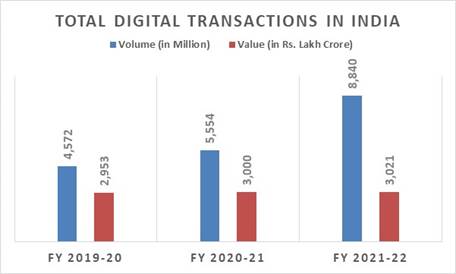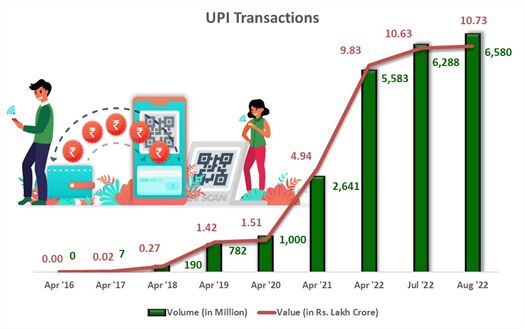Ministry of Finance
Transforming India's Digital Payment Landscape
Posted On: 03 OCT 2022 2:52PM
Recent years have seen a technological revolution in governance in India. Government services have been slowly and steadily brought on board and today, last-mile delivery happens with the click of a mouse in seconds. Digital Payments transactions have been consistently increasing over the last few years, as a part of the Government of India’s strategy to digitise the financial sector and economy. Further, concerted efforts have been made to promote financial inclusion as one of the important national objectives of the country.
The key enabler at the centre of India’s transformed digital payment landscape is the JAM Trinity - Jan Dhan, Aadhaar and Mobile. Pradhan Mantri Jan-Dhan Yojana (PMJDY) is one of the biggest financial inclusion initiatives in the world, launched in August 2014, to provide universal banking services for every unbanked household. Aadhaar, the Unique Identification Authority of India’s flagship product, is a simple but effective method to verify individuals and beneficiaries based on their biometric information. Jan Dhan accounts, Aadhaar and Mobile connections, taken together, have helped lay the foundations of a Digital India where a vast array of Government services are made available directly to the citizen with enhanced ease of access without the presence of any intermediary (middle-men).
Digital Payment Ecosystem in India
One of the major objectives of Digital India is to achieve “Faceless, Paperless, Cashless” status. The promotion of digital payments has been accorded the highest priority by the Government of India to bring each and every segment of our country under the formal fold of digital payment services. The vision is to provide the facility of seamless digital payment to all citizens of India in a convenient, easy, affordable, quick and secured manner.
During the last three years, digital payment transactions have registered unprecedented growth in India. Easy and convenient modes of digital payment, such as Bharat Interface for Money-Unified Payments Interface (BHIM-UPI); Immediate Payment Service (IMPS); pre-paid payment instruments (PPIs) and National Electronic Toll Collection (NETC) system have registered substantial growth and have transformed digital payment ecosystem by increasing Person-to-Person (P2P) as well as Person-to-Merchant (P2M) payments. At the same time, pre-existing payment modes such as debit cards, credit cards, National Electronic Funds Transfer (NEFT) and Real-Time Gross Settlement (RTGS) have also grown at a fast pace. BHIM-UPI has emerged as the preferred payment mode of users. The Government of India also launched the digital payment solution e-RUPI, a cashless and contactless instrument for digital payment which is expected to play a huge role in making Direct Benefit Transfer (DBT) more effective in digital transactions in the country. All these facilities together have created a robust ecosystem for a digital finance economy.

UPI: Revolutionizing Digital Payments
UPI has been termed a revolutionary product in the payment ecosystem. Launched in 2016, it has emerged as one of the most popular tools in the country for carrying out digital transactions. UPI is an instant payment system developed by the National Payments Corporation of India (NPCI). It powers multiple bank accounts into a single mobile application, merging several banking features, seamless fund routing and merchant payments into one hood. To further strengthen and popularise the interface, Prime Minister Narendra Modi launched the BHIM-UPI App during the inauguration of the ‘DigiDhan Mela’ on December 31, 2016.
UPI has gone a long way in making digital payments a habit, and in firmly placing India on the track toward a cashless economy. In the month of August 2022 alone, 346 banks were live on the UPI interface, with 6.58 billion financial transactions being carried out for a total value of nearly Rs. 10.73 lakh crores.

UPI currently constitutes well over 40% of all digital transactions taking place in India. It has given a boost to small businesses and street vendors as it enables fast and secure bank-to-bank transactions even for considerably small amounts. It also facilitates quick money transfers for migrant workers. The technology is convenient to use as it requires minimum physical intervention, making it possible to transfer money simply by scanning a QR code. UPI has also been a saviour during the Covid-19 pandemic, with its adoption expanding rapidly due to its ability to allow easy, contactless transactions.
Today, there is no doubt that the digital payment landscape in India has been transformed. Complementing the efforts of the Government, the people of India have also displayed a great affinity for embracing new technologies. While some of the developed countries are facing problems due to inadequate digital infrastructure for transferring money to the accounts of their citizens, India has emerged as a leader in the creation of digital assets, which can serve as an example to many other nations. Further, the Government of India is leaving no stone unturned to make India a global leader in the arena of digital payment systems and help it attain the status of one of the most efficient payments markets in the world. Going forward, the emerging Fin-Techs will play a key role in the further growth of digital transactions by enabling transparent, secure, swift and cost-effective mechanisms benefiting the entire digital payments ecosystem.
***
AG/HP/RC/PPD/SS
(Features ID: 151163)
Visitor Counter : 1347